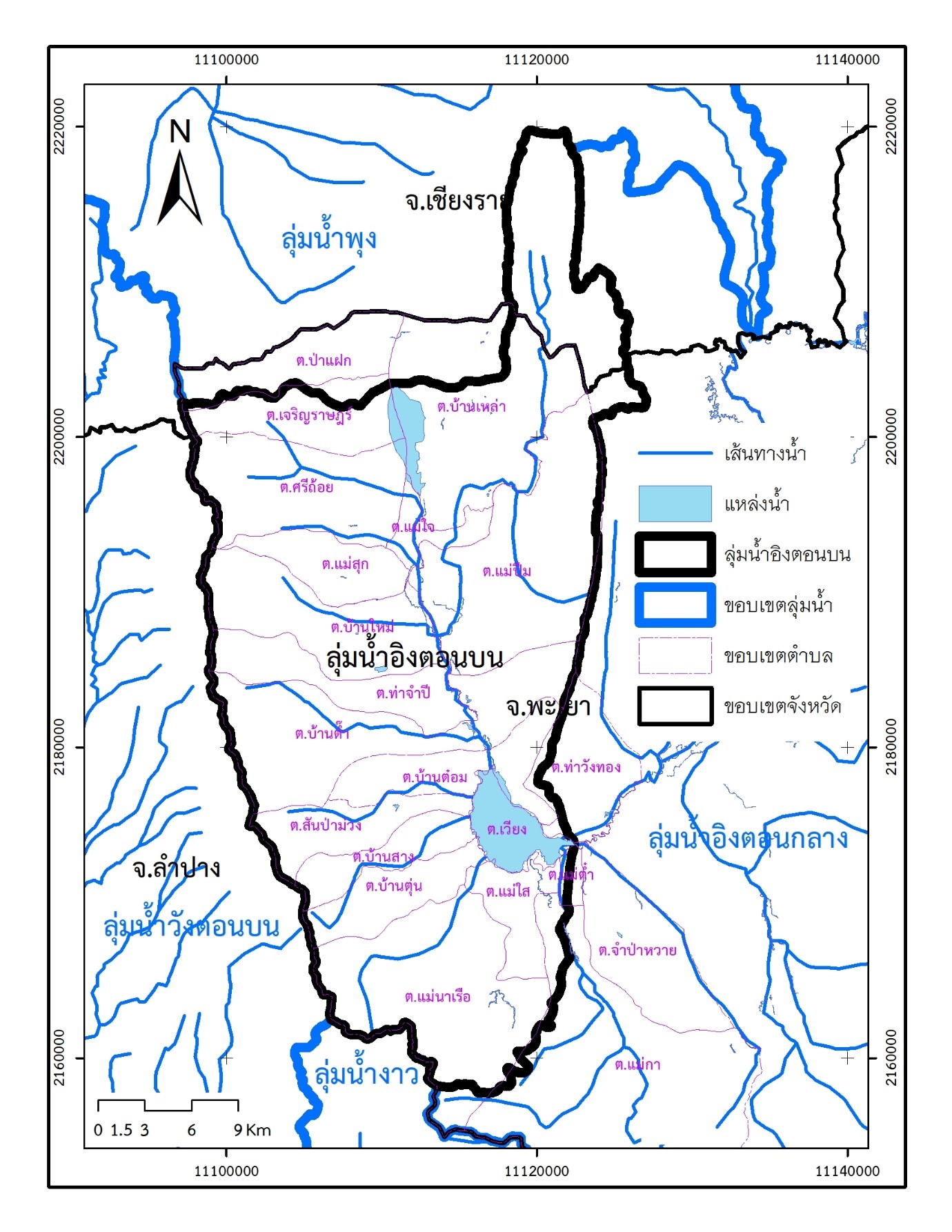Linguistics Map of Ethnic Groups in the Upper Area of Ing River Basin, Phayao Province
Keywords:
Linguistic Maps, Ethnic Group, Upper Area of Ing River BasinAbstract
This study intends to investigate and accumulate any spoken languages, including different ethnic dialects, in the upper area of Ing River basin in Phayao province and to create a linguistic map using geographic information system (GIS). This qualitative study was conducted through interviews and questionnaires to collect data, and descriptive statistics were used to discuss the result of the study. The findings show that there are three types of language communities present in the area: 1) Single-language community: there are 16 villages falling into this category, and the language spoken is Kam Muang (northern dialects). 2) Two-language community: there are 7 villages where the languages spoken are Kam Muang and Isan languages. 3) Three-language community: there are 5 villages where three languages, Kam Muang, Isan, and Central Thai, are spoken.
Further findings also reveal that there are a total of five ethnic groups residing in the upper Ing River basin area. The majority found are Thai Yuan, the local people in the area as well as those residing in the northern part of Thailand, and followed by Thai Isan, Thai Central, Lua, and Lao Wiang groups in descending order. The latter groups are the people who have relocated from other regions through familial relationships such as becoming in-laws of ones of the villages’ members.
References
กาญจนา เงารังษี. (2540). รายงานการวิจัยแผนที่ภาษาในเขตภาคเหนือตอนล่าง. พิษณุโลก: มหาวิทยาลัยนเรศวร.
ชนัญญา พวงทอง และ กฤตานนท์ ท้าววัฒนากุล. (2019). การศึกษาเปรียบเทียบการออกเสียงคำศัพท์ในภาษาจีนกลางและภาษาม้ง. วารสารมังรายสาร, 7(1), 27-39.
ผณินทรา ธีรานนท์, ดารินทร อินทับทิม และ ณัฐวร วงศ์จิตราทร. (2558). พะเยาศึกษา (พิมพ์ครั้งที่ 1). เชียงใหม่: สุเทพการพิมพ์.
พิสิฏฐ์ โคตรสุโพธิ์ และ คณะ. (2557). การถ่ายทอดศิลปะและวัฒนธรรมภูมิปัญญาล้านนาสู่สังคมโดยผู้ทรงภูมิปัญญาท้องถิ่น. เชียงใหม่: นพบุรีการพิมพ์เชียงใหม่.
วิภาวรรณ ถิ่นจันทร์. (2558). การแปรเสียงวรรณยุกต์ของภาษาไทยถิ่นในจังหวัดแพร่ (วิทยานิพนธ์มหาบัณฑิต), มหาวิทยาลัยธรรมศาสตร์, กรุงเทพฯ.
วิภพ แพงวังทอง, ทัชดารัตน์ รัตน์น้ำหิน, ธนภัทร งามขำ, วรรณิภา ใจยา, อังคณา ราชูการ, จิราพร กุลสุนทรรัตน์ และรังสรรค์ เกตุอ๊อต. (2563). การประเมินการปล่อยคาร์บอนไดออกไซด์จากการสัญจรบนถนนในชั่วโมงเร่งด่วนเพื่อสนับสนุนแผนลดผลกระทบด้านสิ่งแวดล้อมบริเวณหน้ามหาวิทยาลัยพะเยา. วารสารวิชาการเพื่อการพัฒนานวัตกรรมเชิงพื้นที่, 4(2), 79-92.
สมทรง บุรุษพัฒน์ และคณะ. (2554). การใช้ภาษาและทัศนคติต่อภาษาและการท่องเที่ยวเชิงชาติพันธุ์ของกลุ่มชาติพันธุ์ในภูมิภาคตะวันตกของประเทศไทย. นครปฐม: สถาบันวิจัยภาษาและวัฒนธรรมเอเชีย มหาวิทยาลัยมหิดล.
สุระ พัฒนเกียรติ. (2546). หลักเบื้องต้นระบบสารสนเทศทางภูมิศาสตร์ในการจัดการทรัพยากรธรรมชาติและสิ่งแวดล้อม. นครปฐม: มหาวิทยาลัยมหิดล.
สุวัฒนา เลี่ยมประวัติ. (2557). รายงานการวิจัยแผนที่ภาษาศาสตร์จังหวัดสุพรรณบุรี. นครปฐม: มหาวิทยาลัยศิลปากร .
สุวัฒนา เลี่ยมประวัติ. (2560). แผนที่ภาษาศาสตร์จังหวัดสุพรรณบุรี. วารสารมหาวิทยาลัยศิลปากร ฉบับ ภาษาไทย, 37(1), 277-302.
สุวิไล เปรมศรีรัตน์ และคณะ. (2548). แผนที่ภาษาและกลุ่มชาติพันธุ์ต่าง ๆ ในประเทศไทย. กรุงเทพฯ: โรงพิมพ์คุรุสภาลาดพร้าว.
Gedney, William. (1972). A checklist for determining tones in Tai dialects. In R.J. Bickner et al. (eds.), Selected Papers on Comparative Tai Studies. Center for South and Southeast Asian studies, The University of Michigan, 191-206.
Li, F. K. (1959). Classification by Vocabulary: Tai Dialects. Anthropological Linguistica, 2, 15–21.
Matisoff. (1991). Sino-Tibetan Linguistics: Present State and Future Prospects. Annual Review of Anthropology, 20(1), 469-504.





